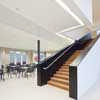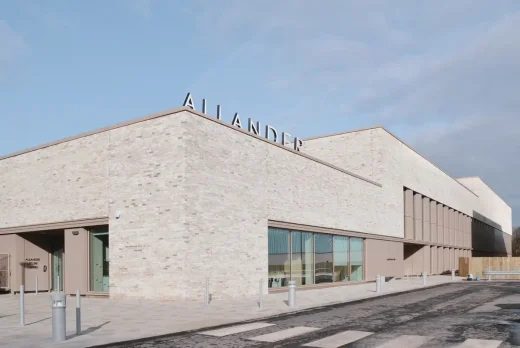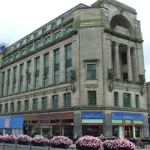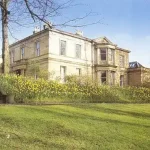Maryhill Burgh Halls, Building, Architect, Project, Images, Info
Maryhill Burgh Halls, Glasgow
HLF-funded Development, Scotland – Historic Building in Strathclyde
30 Jan 2009
HLF funding saves Maryhill Burgh Halls and gives regeneration the green light
Maryhill Burgh Halls Glasgow
One of Glasgow’s areas of highest deprivation has been thrown a lifeline with a grant of almost £1million from the Heritage Lottery Fund (HLF) to restore the derelict Maryhill Burgh Halls. Announced today by HLF, the project will see the Burgh Halls and adjacent former police station not only transformed into a hub for community life but also become a key element in an ambitious £9m regeneration project for the area.
To mark the restoration project, a ‘Journeymen’* installation has been placed above the front portico of the Maryhill Burgh Halls building. Patricia Ferguson, local MSP, Colin McLean, Head of the Heritage Lottery Fund in Scotland and Billy McAllister, Chair of the Maryhill Burgh Halls Trust will be available for pictures with the sculptures and interview at 9.45am on Friday 30 January at
Maryhill Burgh Halls Address:
10 Gairbraid Avenue/1513 Maryhill Road, G20 8YE
Location: junction of Maryhill Road & Gairbraid Avenue opposite Maryhill Library)
One of the few remaining historic buildings in the area, Maryhill Burgh Halls was officially opened in 1878. It has lain empty for the past eight years and is listed on the buildings at risk register. Today’s grant of £990,000 will see the neglected buildings developed into a modern public hall, cafe, 11 offices, a commercial and a community recording studio, nursery, meeting rooms and public garden.
The restoration of Maryhill Burgh Halls will also see a significant collection of 20 stained glass windows conserved and returned to the Burgh Halls on a rotational basis. These were designed by the studio of Stephen Adam, an internationally important artist in the field of stained glass design and they depict the 19th century trades of Maryhill, including linen bleachers, canal boatmen and calico printers. The windows were removed from the building in 1963 and most have been kept in storage at the Burrell Collection ever since. They have been carefully recreated using animation and light and images of the windows are currently projected onto the building each evening in the run up to their return.
The restoration of Maryhill Burgh Halls and Police Station will form an integral part of the adjacent development of a new swimming pool and leisure facility by Glasgow City Council. The historic facade of the former fire station will form a common arched entrance courtyard to both the Burgh Halls and the leisure centre.
Commenting on the today’s grant announcement, Colin McLean, Head of the Heritage Lottery Fund in Scotland, said:
“This important civic building has given the community of Maryhill a heart for over 100 years, a symbol of history and identity that cannot be replaced. Today it stands empty and derelict.
“At the Heritage Lottery Fund, we believe that breathing new life into the Burgh Halls will not only re-establish it as a centre of community life and make a marked contribution to the economics of the area but will also give a renewed sense of pride. This major investment of Lottery players’ money is exciting news and an important step forward in the revitalisation of modern-day Maryhill”.
Local MSP. Patricia Ferguson, added:
“Maryhill was a Police Burgh for only 10 years but the Burgh Hall has been part of our history for over 100 years. With the help of the Heritage Lottery Fund we have the opportunity to restore this important building to its rightful place at the heart of our community.”
Billy McAllister, Chair of Maryhill Burgh Halls Trust said:
“The Board of the Trust is absolutely delighted to be awarded this very substantial grant which is crucial for unlocking opportunities for the Trust to secure the balance of funding to deliver our ambitious and much needed community project. Our sincere thanks go to the Heritage Lottery Fund for supporting this important and historically significant initiative for the people of Maryhill. So far, more than 5 years hard work has been put into developing proposals for the Maryhill Burgh Halls project.
The Board of the Trust, which comprises local people and representatives from partners Maryhill Housing Association, Cube Housing Association and Glasgow City Council have worked tirelessly to get to where we are today, as have members of our support team. We have made sure to regularly consult and involve local people, schools and a variety of organisations and have maximised opportunities to promote our hugely significant heritage assets at events such as Doors Open Day over the past few years. The Trust will continue to do this and I am confident that before long, we will be celebrating the re-opening of what is and will continue to be a much loved hub for the local community for generations to come.”
*The Journeymen were a tribe of 30 free-standing eight feet tall orange figures created by the Heisenberg art collaborative as part of Glasgow 1999, Year of Architecture and Design. They were intended to highlight a series of chosen spaces and bring them back into public consciousness, and appeared in unlikely places across the city throughout the year, most notably on the M8′s Road to Nowhere, Formed by architect Dan Dubowitz and sculptor Matt Baker, Heisenberg installations are a reminder of what we fail to see.
The Heritage Lottery Fund (HLF) enables communities to celebrate, look after and learn more about our diverse heritage. From our great museums and historic buildings to local parks and beauty spots or recording and celebrating traditions, customs and history, HLF grants open up our nation’s heritage for everyone to enjoy. To date it has invested over £500million in Scotland’s heritage.
In 2005, HLF invested £357,000 in Maryhill in the restoration of Queens Cross Church. The church was designed by Charles Rennie Mackintosh in 1896 and is recognised as an important early Mackintosh building which is almost wholly authentic and intact. The building is of outstanding importance to the architectural history of Glasgow and the UK.
Maryhill Burgh Halls was formally opened on Friday 26th April 1878. It came about due to the result of the increasing population growth in the town and the lawlessness this created. The H.M. Inspector of Police for Scotland insisted that the Maryhill Police Commissioners took steps to provide a more suitable building for police purposes. They accordingly feued a portion of ground at the junction of Gairbraid Avenue and Wyndford Street, (now Maryhill Road) and plans were prepared, which included the necessary police accommodation, court room, and a public hall to seat 900.The design work was carried out by Duncan McNaughtan a local Glasgow based architect and resembles a French hotel.
The overall proposals consist of a blend of well considered and sensitive historic building restoration with strong contemporary new build additions. So far, funding has reached c £2.5 million. An Advance Works package to stabilise the buildings and restore the stonework and windows to the street elevations has already been carried out over the past year or so.
Several major funding applications are in the pipeline to secure the balance of funding for the project. It is anticipated that a start on site with the main construction works will take place in the late summer of this year
Other funders for the project to date include The Scottish Government, Housing and Regeneration Directorate, Regeneration Division, (formerly Communities Scotland), Glasgow City Council, the Community Regeneration Fund, Cube Housing Association, Maryhill Housing Association, the Scottish Executive Cities Growth Fund, the Heritage Lottery Fund & several other organisations & individuals
An exhibition about the Maryhill Burgh Halls project is currently in Maryhill Library during normal opening hours. The project team for the main building proposals is:
Gardiner and Theobald – Project Managers, Quantity Surveyors and Planning Supervisors: JM Architects: Buro Happold – Structural and Services Engineers
The Conservation Management Plan has been carried out by Austin, Smith, Lord – Architects. The Designer of the Illumination Project is Adrian Stewart of DO Architecture.
Maryhill Burgh Halls Award News

photo : McAteer Photo
Maryhill Burgh Halls Building
Maryhill Buildings
Design: Holmes Miller

image courtesy of architects practice
Allander Leisure Centre Building in Bearsden
photograph © Adrian Welch
Burrell Museum
Comments / photos for the Maryhill Burgh Halls Glasgow Building page welcome
Website: www.maryhillburghhalls.org.uk

